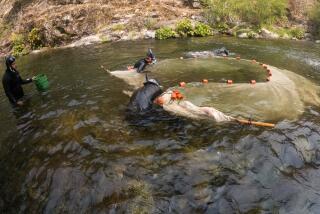Goin’ Fishing for a Better Catch
- Share via
MACKAY, Idaho — At the foot of a high central Idaho mountain, half a million baby kokanee salmon dart back and forth in a concrete raceway like flashing silver arrows.
It’s mid-April, and a wet snow is raining down like spitballs from a swirling gray sky.
Idaho Department of Fish and Game employees huddle near a space heater inside a large tent, plastic buckets between their knees and tubs of water all around them.
One by one, they grab minnow-sized kokanee from the holding tubs, dunk the fish in a mild anesthetic solution and then, with the smallest of scissors, snip off one of the belly fins to mark them as hatchery fish.
Occasionally, a fish flips out of a bucket and hits the ground.
“Ho! Come back here, little guy,” says Joe Kozfkey, pinning the salmonid with his thumb and tossing it back into the bucket.
Kozfkey is a senior fisheries biologist who has helped refine Idaho’s unique sterilization program for trout, kokanee and other species. This year, about 110,000 kokanee are being processed as part of an expanded sterilization program in five reservoirs around the state.
Idaho is the only state that extensively uses a heat or pressure process on fish eggs to blunt the sexual maturity of its hatchery trout, kokanee salmon and other species. It is also the only state that attempts to ensure the sterility of every stocked trout.
This year, the Department of Fish and Game will grow and stock 1 million pounds of sterile hatchery trout, said Jeff Dillon, regional fishery manager for Idaho’s southwest region.
Dillon, along with senior research manager Dan Schill and fisheries manager Doug Megargle, recently won a national award for the department’s sterilization program.
“Other states dabbled, but we are the first in the Lower 48 to implement on a statewide basis,” Dillon said. “We were the first to take it to this level.”
Decades ago, fishermen were mainly concerned with putting more fish on the table; it mattered less whether it was wild or stocked fish. But as cookie-cutter hatchery rainbow trout began to interbreed with wild stocks, anglers began to notice.
Hatchery fish fight less. Their colors tend to be more subdued. Some say they don’t taste the same. But protecting the genetics of wild fish stocks is at odds with the agency’s primary duty -- to help everybody catch fish.
As the process developed over time and became more reliable, managers found that sterilized hatchery trout could be stocked in any of Idaho’s rivers, streams and lakes to provide catchable food. Yet the hatchery fish -- called a “triploid” -- also carries with it an invisible biological barrier to wild stocks.
Since the first batches of triploids were released into the wild 10 years ago, surveys and tests show that the fish not only survive, but often thrive. The energy they would have expended to develop to sexual maturity can instead be focused on physical development.
In the case of the kokanee, the salmon’s lifespan is extended from three to about five years.
“In these reservoir systems where they don’t have good spawning habitat, [fertile kokanee] try to spawn and die, and we don’t get anything out of it,” Kozfkey said.
When the kokanee fish are sterilized, they remain sexually immature their whole lives. Females don’t develop eggs and males don’t develop sperm. Since it takes kokanee salmon about three years to develop into a catchable-size fish, fertile fish often try to spawn and die without ever seeing an angler’s hook.
“But if we get them up to that size and they stay at that size, we can increase catch rates for kokanee in some of these fisheries where we don’t get any natural spawning,” Kozfkey said.
Still, the triploid program isn’t the perfect answer, said Todd Carter, vice president of the Idaho Council of Trout Unlimited, especially when it comes to the trout programs.
Rainbow trout are now a worldwide fish that are taking over and hybridizing with pure native stocks, such as Yellowstone cutthroat trout.
“Even though they claim triploids are sterile, there is a small percentage that are not. It’s kind of a misnomer,” Carter said. “There needs to be a give and take between providing for family fisheries and protecting waters that are more sensitive to hybridization.”
Dillon acknowledged that about 1% or 2% of the fish subjected to the treatment may still be fertile. “From our perspective, when we couple that with how well these fish survive in the wild, we’ve slimmed down the odds a lot,” Dillon said. “Sometimes, we have to remind folks that we stock fish because the public wants that opportunity [to catch them]. We can’t provide that with wild fish.”
More to Read
Sign up for Essential California
The most important California stories and recommendations in your inbox every morning.
You may occasionally receive promotional content from the Los Angeles Times.













